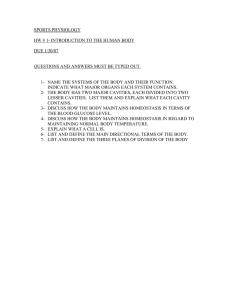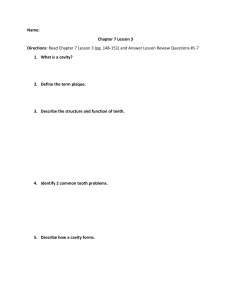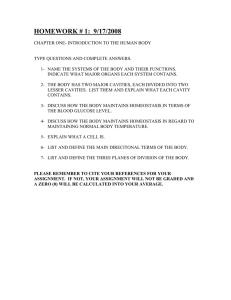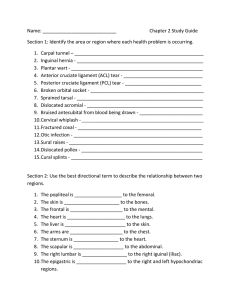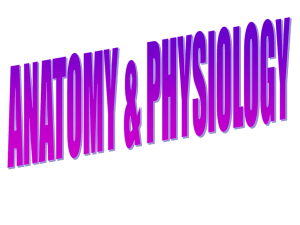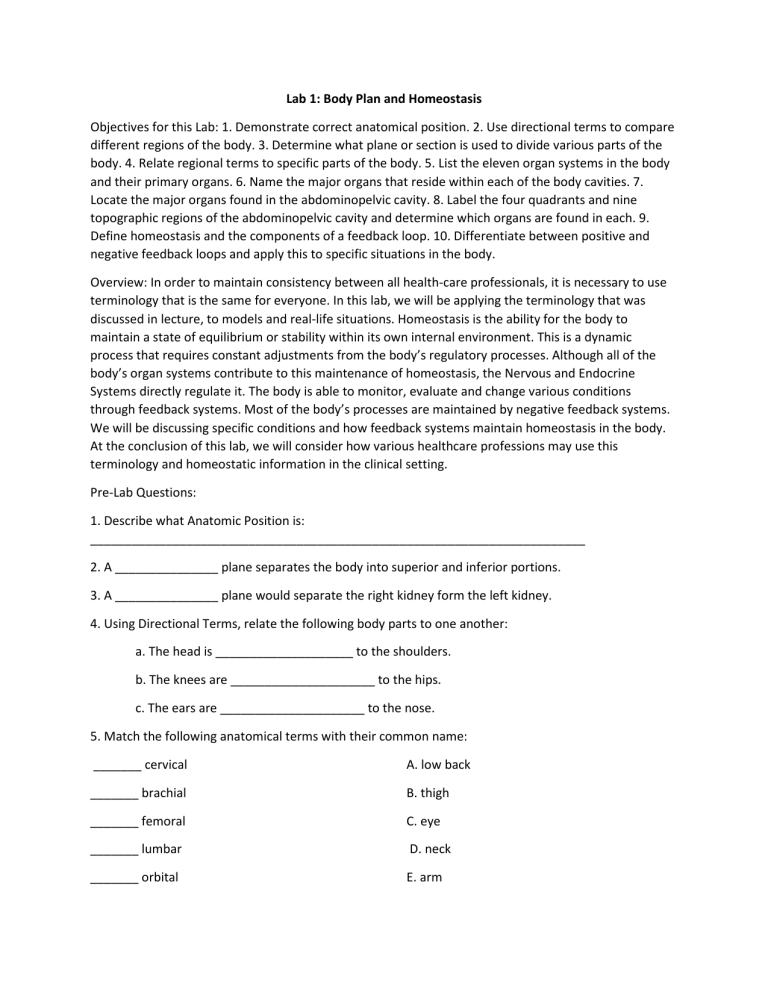
Lab 1: Body Plan and Homeostasis Objectives for this Lab: 1. Demonstrate correct anatomical position. 2. Use directional terms to compare different regions of the body. 3. Determine what plane or section is used to divide various parts of the body. 4. Relate regional terms to specific parts of the body. 5. List the eleven organ systems in the body and their primary organs. 6. Name the major organs that reside within each of the body cavities. 7. Locate the major organs found in the abdominopelvic cavity. 8. Label the four quadrants and nine topographic regions of the abdominopelvic cavity and determine which organs are found in each. 9. Define homeostasis and the components of a feedback loop. 10. Differentiate between positive and negative feedback loops and apply this to specific situations in the body. Overview: In order to maintain consistency between all health-care professionals, it is necessary to use terminology that is the same for everyone. In this lab, we will be applying the terminology that was discussed in lecture, to models and real-life situations. Homeostasis is the ability for the body to maintain a state of equilibrium or stability within its own internal environment. This is a dynamic process that requires constant adjustments from the body’s regulatory processes. Although all of the body’s organ systems contribute to this maintenance of homeostasis, the Nervous and Endocrine Systems directly regulate it. The body is able to monitor, evaluate and change various conditions through feedback systems. Most of the body’s processes are maintained by negative feedback systems. We will be discussing specific conditions and how feedback systems maintain homeostasis in the body. At the conclusion of this lab, we will consider how various healthcare professions may use this terminology and homeostatic information in the clinical setting. Pre-Lab Questions: 1. Describe what Anatomic Position is: ________________________________________________________________________ 2. A _______________ plane separates the body into superior and inferior portions. 3. A _______________ plane would separate the right kidney form the left kidney. 4. Using Directional Terms, relate the following body parts to one another: a. The head is ____________________ to the shoulders. b. The knees are _____________________ to the hips. c. The ears are _____________________ to the nose. 5. Match the following anatomical terms with their common name: _______ cervical A. low back _______ brachial B. thigh _______ femoral C. eye _______ lumbar D. neck _______ orbital E. arm 6. The Dorsal Cavity is divided into ______________ and _______________ cavities. 7. List 4 organs that are found in the Abdominal Cavity: ________________________________________________________________________ 8. Match the following organs with their correct Organ System: ________ heart A. Nervous System ________ stomach B. Digestive System ________ kidneys C. Respiratory System ________ brain D. Urinary System ________ lungs E. Cardiovascular System 9. Which two Organ Systems directly regulate homeostasis: _____________________________ 10. A _______________ feedback system negates or reverses the original condition or stimulus. 11. In a negative feedback system, if blood pressure is increasing, will it continue to increase or will it decrease? ___________________________ 12. True or False. The plasma membrane is composed of lipids and proteins. 12. The plasma membrane is “selectively permeable”. What does this mean? ________________________________________________________________________ _______________________________________________________________________ 13. Match the following organelles with its function: _______ mitochondria A. protein synthesis _______ ribosome B. synthesizes and transports lipids _______ golgi apparatus C. contains enzymes that breakdown substances _______ lysosome _______ smooth endoplasmic reticulum D. generates most of the cell’s ATP E. modifies and transports protein 14. Which of the following events occur during Interphase? Check all that apply. ___ the chromosomes line up in the center of the cell ___ chromatin uncoils and becomes rodshaped chromosomes ___ DNA is replicated ___ the nucleolus disappears ___ enzymes and proteins are synthesized ___ the organelles are replicated 15. List the 4 phases of Mitosis in order. ________________________________________________________________________ Exercise 1.1: Directional Terms Using the torso models in the lab, label the following Directional Terms on the images below: A. Superior E. Proximal B. Inferior F. Distal C. Medial G. Anterior D. Lateral H. Posterior Exercise 1.2: Planes of the Body Using the torso models in the lab, label the following image with the correct Planes or Sections: A. Sagittal Section B. Frontal/Coronal Section C. Transverse Section D. Oblique Section Exercise 1.3: Body Cavities While observing the torso models in the lab, label the following cavities and their sub-cavities on the image below: A. Dorsal Cavity F. Vertebral Cavity B. Ventral Cavity G. Abdominal Cavity C. Cranial Cavity H. Pleural Cavity D. Thoracic I. Pericardial Cavity E. Pelvic Cavity J. Abdominopelvic Exercise 1.4: Regional Terms Label the following anatomical terms on the image below: G. Thoracic A. Cervical H. Pelvic B. Lumbar I. Femoral C. Buccal J. Palmar D. Axillary K. Plantar E. Brachial L. Cephalic F. Orbital M. Vertebral N. Gluteal O. Digital P. Sacral Q. Inguinal R. Olecranal Exercise 1.5: Topographic Regions of the Abdominopelvic Cavity Label the 4 Quadrants and then the 9 topographic regions of the abdominopelvic cavity on the images following: Abdominopelvic Regions 1. 2. 3. 4. 5. 6. 7. 8. 9. Exercise 1.6: Organ Identification Locate the following organs and label them on the picture below: A. Lungs B. Heart C. Liver D. Pancreas E. Stomach F. Gallbladder G. Small intestines H. Large intestines: - Cecum - Transverse colon - Ascending colon - Descending colon - Sigmoid colon Exercise 1.7: Homeostasis and Feedback Loops Label the different components of a feedback system: Stimulus, Receptor, Control Center, Effector Exercise 1.8: Cell Organelle Identification Using the cell models in the lab, label the following organelles/structures on the image below. G. Smooth and Rough Endoplasmic Reticulum A. Plasma Membrane H. Ribosome B. Nucleus C. Nucleolus I. Lysosome D. Nuclear Membrane J. Centrosome E. Mitochondria K. Secretory Vesicle F. Golgi Apparatus Exercise 1.9: Identifying the Stages of Mitosis Using the Mitosis models in the lab, correctly identify the 4 stages of Mitosis. Determine what stage of the cell cycle and mitosis the following pictures are demonstrating.



